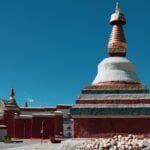After the fall of the Tibet Empire, the emergence of the Guge kingdom became significant from the 10th century to the 17th century. However, a conflict in 1630 led to the downfall of the entire kingdom. The rise and fall of the Guge kingdom remains a mystery to this day. There are a total of 1,416 surviving structures from the Guge kingdom, including caves, residences, watchtowers, and ancient towers, scattered across a slope that is over 300 meters high. As the capital of the ancient kingdom, it boasts the largest architectural complex in Tibet. The Crimson Hall, Ivory Hall, and Yamantaka Hall are relatively well-preserved.

It is a marvel of Nagri. In the mid-9th century, the Tubo imperial court came to a close. The descendants of King Namdam established their own realms, and Gyede Nyinmagong became the ruler of Ngari. Among his three sons, the second son seized control of Zarang and founded the Guge Kingdom.
In the heart of Zarang, the primary remains of the Guge Kingdom stand as a testament to the rich history and cultural heritage of Tibet. Here, the ruins of a once magnificent city merge seamlessly with the surrounding natural beauty, creating a harmonious blend of human architecture and earthen forests. Stretching across a vast expanse of 720,000 square meters, the Zarang Ruins served as the capital of the Guge Kingdom.
As you wander through this sprawling complex, you will be captivated by the sheer magnitude of its architectural wonders. With over 400 residences and 800 caves scattered along the 300-meter-high mountainside, it is a sight to behold. As you approach the ruins, the towering city walls loom before you, their weathered stones whispering stories of a bygone era. These walls, once fortified and formidable, now stand as a gentle reminder of the kingdom’s former grandeur. They have witnessed the rise and fall of dynasties, the ebb and flow of time itself.
Venturing deeper into the complex, you will discover a labyrinth of caves etched into the mountainside. These caves served as dwellings for the people of the Guge Kingdom, providing them shelter and a sense of belonging amidst the rugged terrain. Each cave is a window into the past, offering a glimpse into the daily lives and aspirations of those who once called this place home.
The architectural marvels of the Zarang Ruins are a testament to the ingenuity and craftsmanship of the Guge Kingdom. Intricate carvings adorn the walls, depicting scenes from myth and legend. The attention to detail is awe-inspiring, with every brushstroke telling a story of its own. As you trace your fingers along the ancient carvings, you can almost feel the echoes of the past reverberating through your fingertips. While the Zarang Ruins hold their own charm and allure, they pale in comparison to the majestic Potala Palace, Tibet’s crowning jewel.
As you stand amidst the ruins of Zarang and gaze upon the magnificence of the Potala Palace, you can’t help but feel a profound connection to the past. These architectural wonders are more than just bricks and mortar; they are the embodiment of a people’s resilience, their unwavering spirit, and their enduring legacy. In every crumbling stone and every gentle breeze that rustles through the earthen forests, the stories of the Guge Kingdom and Tibet’s rich cultural heritage come alive.
The ruins of Zarang and the grandeur of the Potala Palace are not merely tourist attractions; they are gateways to a world long gone, inviting us to immerse ourselves in the wonders of history and discover the beauty that lies within.
The key structures include the Scarlet Temple, Ivory Temple, and Mandala Hall. The most valuable feature of the Samsara Hall is the more than 1,000 square meters of murals adorning its walls. In addition to depictions of Buddha, the murals also showcase rare images of other living creatures, including snakes with human heads. The caves surrounding the temples still contain some ancient weaponry and dwellings used by the soldiers of that time.
The Guge Kingdom, also known as the Kingdom of Guge or the Guge Dynasty, was a medieval kingdom that existed in what is now western Tibet, in present-day Ngari Prefecture. It was founded in the 10th century and reached its peak in the 11th and 12th centuries. The Guge Kingdom was known for its strong influence on the cultural, religious, and economic development of the region.
It was a major centre for Buddhist learning and art, and its rulers played significant roles in promoting Buddhism and supporting the construction of monasteries. The kingdom was ruled by a hereditary dynasty of kings, with the ruling monarchs holding the title of “Zapön.”
The Guge Kingdom had close ties with neighbouring kingdoms such as Ladakh and Kashmir, as well as with the broader Tibetan Empire. However, the kingdom faced various challenges throughout its existence, including conflicts with neighbouring kingdoms, internal power struggles, and the decline of the Tibetan Empire. In the 17th century, the kingdom faced a military invasion by the Ladakh forces, which led to the downfall of the Guge Dynasty and the end of the kingdom.
Today, the remnants of the Guge Kingdom can be found in the ruins of Tsaparang, the former capital city, and the surrounding area. These archaeological sites attract tourists and researchers interested in the history and culture of the ancient kingdom.



















